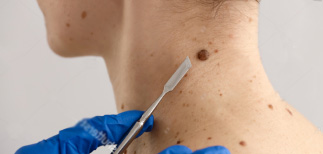Patient Information

This document provides an overview of surgical options, what to expect on the day of surgery, and how to care for the wound post-operatively.
1. Surgical Treatment Options to Remove Moles/Naevi
All moles removed surgically will be sent for **histological analysis** to confirm their nature.
1. a) Shave Excision
- Suitable for superficial or raised moles.
- A dermablade is used to shave the mole down to skin level.
- No stitches are required; the wound heals with a small scab.
1. b) Excision with Stitches
- Used for deeper moles or those suspected of being abnormal.
- The mole is excised with a small margin of surrounding tissue.
- The wound is closed with stitches, which may be dissolvable or require removal.
1. c) Wide Local Excision (WLE)
- Recommended for moles with concerning histology, such as melanoma.
- A larger margin of surrounding skin is removed to ensure complete clearance.
- Stitches or a skin graft may be required.
2. What to Expect on the Day of Surgery
- The procedure is performed under local anaesthetic to numb the area.
- The skin is cleaned, and the mole is removed using one of the methods above.
- The wound is closed, and a dressing is applied.
- The procedure usually takes 15-45 minutes, depending on the mole’s size and location.
- You will receive instructions on wound care before leaving.
3. How to Look After the Wound Post-Surgery
**a) After Shave Excision:**
- A small scab will form, healing within 1-2 weeks.
- Keep the area clean and apply petroleum jelly or a prescribed ointment.
- Avoid picking at the scab to prevent scarring.
**b) After Excision with Stitches:**
- Keep the wound dry for 24-48 hours, then clean gently as advised.
- Stitches on the face are removed in about 5-7 days, while those on the body take 10-14 days.
- Avoid excessive movement that may stretch the wound.
- Once healed, massage the scar with moisturiser or silicone gel to improve appearance.
**c) After Wide Local Excision:**
- More extensive wound care may be required.
- Dressings may need to be changed regularly, and movement should be limited.
- Healing may take several weeks, especially if a skin graft is used.
**Signs of Infection to Watch For:**
- Redness, warmth, or swelling around the wound.
- Increased pain or pus-like discharge.
- Fever or feeling unwell.
Most mole removal procedures heal well with minimal scarring. If you have any concerns, contact your healthcare provider.
Prepared by Dr Sega-Hall
BOOK A CONSULTATION
To book an appointment or to request more information please fill out the form below and we will be in touch shortly. Any information that you provide will remain strictly confidential.